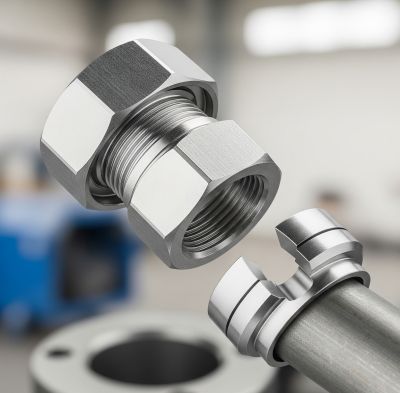Hydraulic systems demand strength, precision, and reliability—especially in industries where downtime is costly. Among the many types of hydraulic fittings, the hydraulic bite type union stands out for its ability to create secure, leak-free connections under extreme conditions.
This guide explores what a hydraulic bite type union is, why it’s crucial in heavy-duty operations, its key features, and how to select the right one for your application.
What is a Hydraulic Bite Type Union?
A hydraulic bite type union is a mechanical fitting used to connect two hydraulic tubes or pipes securely. It uses a special bite-type ferrule that cuts slightly into the outer surface of the tube, creating a tight metal-to-metal seal.
Typically, it consists of:
➡️ Body – houses the connection.
➡️ Ferrule – the biting element that forms the seal.
➡️ Nut – compresses the ferrule onto the tube.
How it Works: Bite Type Ferrule Connection Mechanism
When the nut is tightened, the ferrule’s sharp edge “bites” into the tube surface. This mechanical grip creates a vibration-resistant, high-pressure seal without the need for welding or adhesives.
Common Sizes and Configurations
Hydraulic bite type unions are available in a range of metric and inch sizes to fit tube outer diameters from 4 mm to 42 mm (or 1/8” to 1-1/2”). Common configurations include straight unions, reducing unions, and elbow unions.
What is a Union Type Fitting?
A union fitting is a type of connector that allows two pipes or tubes to be joined while still enabling easy disassembly. It’s widely used in hydraulic and plumbing systems for maintenance and repair access.
What is the Difference Between a Union and a Bushing?
1. Union – Connects two pipes or tubes of the same or different sizes and allows disconnection without cutting.
2. Bushing – Reduces the size of a pipe fitting by connecting a larger fitting to a smaller one. Unlike unions, bushings are not designed for frequent disassembly.
What is a Bite Type Fitting?
A bite type fitting uses a ferrule that bites into the tube’s outer surface during tightening. This creates a highly secure, vibration-resistant seal—ideal for high-pressure hydraulic systems.
Why Choose a Bite Type Union for Heavy-Duty Applications
➡️ High-pressure and vibration resistance – Maintains seal integrity in extreme working conditions.
➡️ Secure, leak-free connections – Reduces the risk of hydraulic fluid loss.
➡️ Easy assembly and maintenance without welding – Saves downtime and labor costs.
➡️ Compatibility with various hydraulic fluids – Works with oil-based, synthetic, and water-based fluids.
Key Features of a Heavy-Duty Hydraulic Bite Type Union
Durable Construction Materials
Available in stainless steel, carbon steel, or brass for optimal performance in specific environments.
Precision Machining for Accuracy
Ensures the ferrule bites correctly for a tight, consistent seal.
Corrosion and Wear Resistance
Protects against rust, pitting, and material degradation in harsh environments.
High Pressure Rating
Suitable for industrial, construction, and marine hydraulic systems with pressures exceeding 6,000 psi, depending on size and material.
Applications in Demanding Industries
Construction Equipment
Excavators, loaders, cranes—where shock loads and vibration are constant.
Mining and Quarry Operations
For equipment exposed to abrasive dust and heavy-duty cycles.
Oil & Gas Pipelines and Machinery
Withstands high pressures and corrosive fluids.
Marine and Offshore Systems
Ideal for saltwater exposure and subsea conditions.
Agricultural and Forestry Machinery
Performs reliably in mud, moisture, and temperature extremes.
Installation and Maintenance Tips
➡️ Prepare tube ends properly – Cut squarely and deburr edges.
➡️ Apply correct torque – Avoid under- or over-tightening.
➡️ Prevent overtightening – This can damage the ferrule or tube.
➡️ Inspect periodically – Check for leaks, wear, or corrosion.
Comparing Bite Type Unions with Other Hydraulic Fittings
Bite type vs. flare fittings – Bite type creates a stronger grip and better vibration resistance; flare fittings require precise flaring tools.
Bite type vs. compression fittings – Bite type provides higher pressure ratings and better sealing under dynamic loads.
Choosing the Right Hydraulic Bite Type Union
Technical Specification Table
|
Size Range |
Material Options |
Max Pressure |
Temperature Range |
Standards |
|
4–42 mm OD |
SS, CS, Brass |
Up to 6,000 psi |
-40°C to +200°C |
DIN 2353, ISO 8434 |
1. Pressure rating – Match to system requirements.
2. Material selection – Stainless steel for corrosion resistance, carbon steel for strength, brass for moderate pressures.
3. Size compatibility – Match tube OD exactly.
4. Environmental conditions – Consider temperature, moisture, and chemical exposure.
5. OEM-quality manufacturing – Ensures precision and reliability.
6. Trusted suppliers – Look for certified manufacturers with proven track records.
FAQ Section
What pressure can a hydraulic bite type union handle?
Depending on material and size, they can handle up to 6,000 psi or more.
Can it be reused after disassembly?
Yes, but the ferrule’s integrity must be checked to ensure it still forms a reliable seal.
Is it suitable for stainless steel tubing?
Yes, when using compatible stainless steel bite type unions and proper installation techniques.
Conclusion
A hydraulic bite type union delivers the secure, leak-free, high-pressure connections that demanding industries require. With durable construction, precise machining, and corrosion resistance, it’s a proven solution for heavy-duty hydraulic systems.
If you’re sourcing hydraulic fittings for your operation, request a catalog or contact us for a tailored quote today.
Post time: Aug-14-2025


